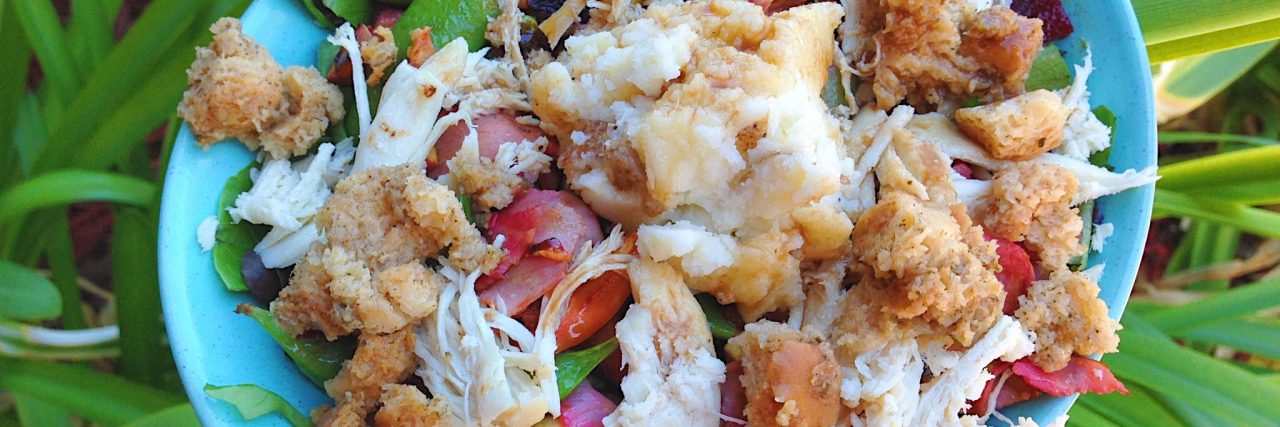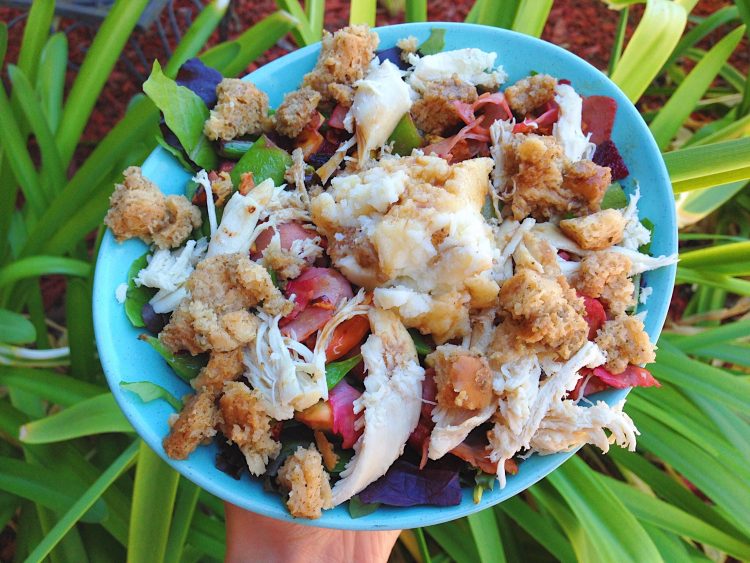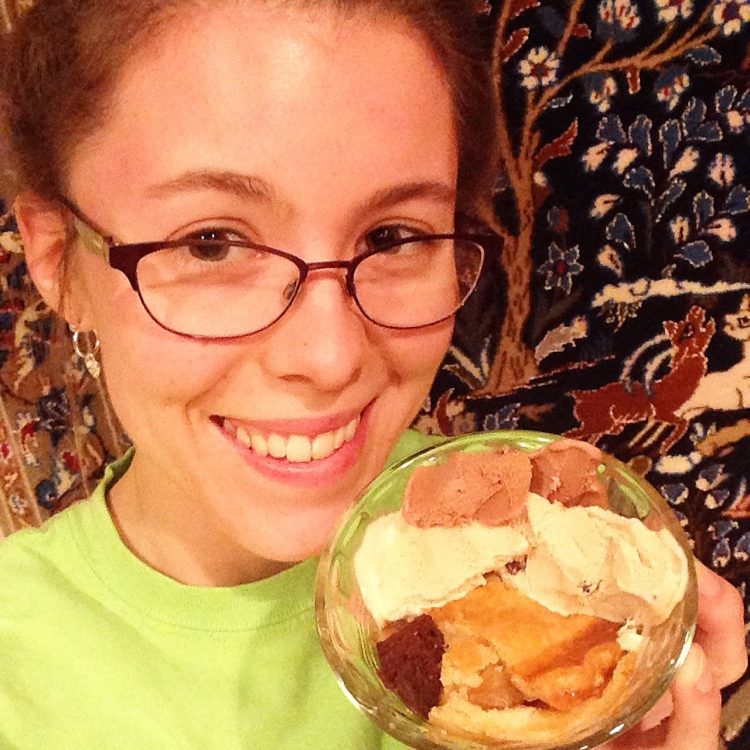For many people, Thanksgiving is the ultimate holiday. After all, what’s more epic than a holiday specifically dedicated to spending time with family, lounging on the coach to watch football and, of course, eating lots of delicious food?
When you have celiac disease, food allergies or other dietary limitations though, Thanksgiving gets a little more complicated. Suddenly, you have to worry about things like cross contamination and offending Grandma Marie by turning down her buttermilk biscuits. Thankfully, though, spreading a little celiac disease and food allergy awareness can go a long way in making Thanksgiving a holiday everyone can enjoy.
So what do people with dietary limitations want others to know about Thanksgiving dinner? Based on my own experience with celiac disease, here are seven things that all Thanksgiving diners should keep in mind!
1. Don’t be offended if we can’t eat Grandma’s “famous” pecan pie.
I promise, I totally wish I could taste the pecan pie that Grandma made from scratch based on a century-old family recipe. And if a “little bite” wouldn’t seriously hurt me (aka: gluten me and turn me into a brain-fogged, bloated zombie for at least a week), I’d “even just try the filling.”
However, I have the right – and the responsibility – to put my own health and well-being over being polite. So please don’t be offended if I turn down offers of food with a simple, “Thank you, but I need to follow a strict gluten-free diet.”
On a related note, don’t feel embarrassed for not knowing what a “gluten-free diet” is or feel bad for forgetting and offering me more food, either. I’m used to explaining my diet and advocating for myself on a daily basis…and most people with dietary restrictions can probably relate.
And, whether I can eat the food or not, it’s always nice to feel like people are trying to make me feel at home and well-fed!
2. We appreciate it when you try to accommodate our dietary needs…
The longer I’ve been diagnosed with celiac disease, the more amazed I’ve been at how far loved ones are willing to go to accommodate my gluten-free diet. When I’m home for Thanksgiving, my parents and sister cook a 90 percent gluten-free Thanksgiving dinner, with the only gluten typically being a few bread rolls and a traditional green bean casserole for my dad. A few years ago, we even had an entirely gluten-free Thanksgiving, complete with a gluten-free green bean casserole, amazing rolls from a local GF bakery and apple pie for dessert.
I know not all families or friends are able to host an allergy-friendly Thanksgiving dinner, and I don’t think people should feel obligated to try. As I’ll discuss in the next point, cooking gluten-free or allergy-friendly is often a lot more complicated than people realize, and “gluten-free” meals made by inexperienced cooks may still contain dangerous cross contamination.
When friends or family do offer to alter their Thanksgiving dinner recipes on my behalf, though, I feel extra loved – even if that offer doesn’t become a reality. And I doubt I’m the only gluten-free foodie who’s appreciated similar offers or allergy-friendly Thanksgiving dinners.
3. …but sometimes, it’s easier (and safer) to just bring our own food.
As mentioned above, it’s super cool of people to offer to accommodate my gluten-free diet during Thanksgiving. When I’m not spending the holidays with my immediate family, though, I often respond, “I really appreciate the offer, but it’s actually easier and safer for me to just bring my own food this year. Is that OK?”
Just like I need to read the labels of “gluten-free” foods that friends bring me to make sure the treat is celiac-safe, eating gluten-free food prepared by other people typically requires a long conversation about the ingredients, pots and cooking utensils used. If you have gluten intolerance or less sensitive dietary limitations, you might be able to accept allergy-friendly meals with less worry.
For people with celiac disease or other dietary restrictions that require no cross contamination though, eating slightly questionable food can result in worrying about the food’s safety the whole dinner. Bringing our own allergy-friendly Thanksgiving feast often gives us the best of both worlds: time with loved ones and some delicious, safe food!
4. If we do eat something different, please don’t feel the need to point it out.
I’ve found that hosts rarely mind if I bring my own Thanksgiving dinner in Tupperware; however, eating a different meal than everyone else can feel awkward at times, especially if people can’t stop talking about it.
Of course, if someone sees the gluten-free popcorn pumpkin balls I packed for dessert and comments on how delicious they look, I’ll smile and thank them. That’s very different though, from:
- Asking me about every single ingredient I used in my meal,
- Saying how “weird” gluten-free food is and how they had a *insert random friend or relative here* who went gluten-free once and that their food tasted horrible,
- Telling me I’m “lucky I can’t eat the bread rolls so I can stay skinny,” or
- Endlessly exclaiming how delicious the “regular” food is and asking if I miss eating “normal” food and if I’m sure I can’t even eat just a bite.
(And, yes, I’ve experienced moments of each of those, though not always on Thanksgiving).
I can’t speak for everyone with celiac disease, food allergies or dietary limitations, but I personally don’t mind questions about my food or celiac disease as long as they are respectful and the person sincerely wants to learn more.
However, when people make comments like those listed above or seem incapable of letting me just blend in with everyone else, it’s hard to not feel awkward and isolated. So, when in doubt, spend more time talking to people about who they are and what they do and less time talking about what they eat!
5. Stay open-minded…and open-mouthed!
On a similar note, don’t automatically turn up your nose at a gluten-free recipe we bring to Thanksgiving dinner to share. I’ll be the first to say that 99 percent of allergy-friendly recipes do not taste exactly like their traditional counterparts. Unless you’re using a really stellar gluten-free recipe, gluten-free bread will not taste like the flaky pre-made crescent rolls you used to enjoy eating. That’s just reality.
However, allergy-friendly food can still be flippin’ delicious, and I’ve come to love people who have an open mind and are always willing to try new gluten-free recipes. Who knows? Maybe the slightly “weird” gluten-free and vegan Thanksgiving dessert your celiac niece brings to dinner will become a new family favorite!
6. If there are allergy friendly dishes for everyone to enjoy, please pay attention to cross contamination rules.
Depending on how many people need allergy-friendly options or the set-up of the Thanksgiving dinner (for example, a potluck with friends instead of one person cooking everything), you might see several allergy friendly Thanksgiving sides, main dishes and desserts on your table this year. If there are eaters who need to avoid cross contamination, please follow the rules they’ve established.
Many times, these “rules” can involve using specific, separate serving utensils for each dish, that way the gluten-filled gravy doesn’t touch the gluten-free mashed potatoes, etc. Your family or friends might also consider letting the person with celiac disease or dietary restrictions serve themselves first, so they know people haven’t accidentally used the wrong utensils or put contaminated leftovers back in the original container.
We know that using a specific utensil or keeping the allergy-friendly Thanksgiving dishes in another section of the kitchen might sometimes feel annoying or like overkill. However, these little actions can literally keep the food from killing us. And trust us. Thanksgiving dinner is much more enjoyable for everyone when we can eat without any negative effects!
7. Remember – Thanksgiving is about the people, not the food, anyway!
This is perhaps the most important thing I want everyone to know about having Thanksgiving dinner with celiacs or dietarily limited loved ones. It’s easy to think of Thanksgiving only in terms of food we eat during it. After all, grocery stores are overflowing with holiday foods, restaurant commercials are full of turkey dinners and sitting around the dinner table is often the highlight of Thanksgiving.
However, Thanksgiving – at its core – is not about food at all. It’s about being thankful for all the blessings we’ve had that year, and we can be plenty grateful even without a full dinner plate. We can spend the afternoon catching up with friends and family. We can bond over a good game of football or a long walk before dinner. And, yes, we can even form special Thanksgiving dinner memories that have nothing to do with the dinner itself.
At first glance – or even during the first year after a celiac disease diagnosis or a big diet change – enjoying Thanksgiving with dietary restrictions can be challenging. It can be just as challenging to know how to act as loved ones and friends of those who can’t eat a traditional Thanksgiving dinner.
However, as these seven reminders show, we don’t actually need people to know a lot about our diet or medical condition to make us feel at home during Thanksgiving. Being respectfully curious, open-minded and flexible can go a long way in making this year’s Thanksgiving dinner the best yet…regardless of whether everyone’s dinner plate looks like the same.
Have an amazing Thanksgiving, everyone!
This post first appeared on my blog, Casey the College Celiac.
We want to hear your story. Become a Mighty contributor here.



